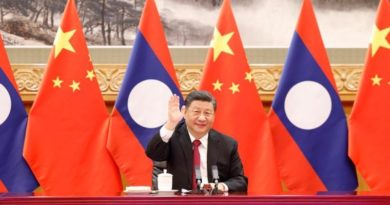“Laos’ Falling Currency Has Made Debt Payments Challenging” – ADB Expert
Source: Radio Free Asia
The steadily declining value of Laos’ national currency has made it increasingly difficult for the government to make its regular debt payments, an Asian Development Bank financial expert told Radio Free Asia.
The Ministry of Finance typically has to exchange the kip for U.S. dollars, Thai baht or Chinese yuan before making payments, according to the Vientiane-based financial expert, who requested anonymity due to the diplomatically sensitive information he was conveying.
The kip weakened by 31% against the dollar last year – a trend that was expected to continue in 2024, according to the World Bank.
The government will need at least US$10 billion this year to cover all debt-related expenses, but Laos’ central bank – the Bank of Lao P.D.R. – has so far only brought in US$3 billion, Minister of Finance Santiphab Phomvihanh told National Assembly lawmakers on Monday.
The government is working to improve tax collection from businesses with the aim of taming the debt payments, he said.
“We’re requesting the big businesses to pay their taxes regularly and on time,” he said. “Mega projects like dam construction, mining operations, expressway construction, transport and digital trades – including online marketing – must pay their dues.”
Prime Minister Sonexay Siphandone also spoke with lawmakers about the debt issue on Monday, saying that the government recently sold bonds worth 8 trillion kip (US$368 million).
“Under my watch, I will never allow our country to default on debt,” he said.

We are Your Marketing Partners in Laos
What’s owed to China
Laos’ economy continues to face challenges brought on by the COVID-19 pandemic. The number of visits by international tourists remains low, for example.
A shortage of foreign currencies needed to pay down debt and fund development projects has been a main driver of the kip’s depreciation, the World Bank said last December.
A 2010 World Bank study found that countries whose debt-to-gross domestic product ratios exceed 77% eventually undergo notable slowdowns in economic growth.
Laos’ national debt has risen to 112 percent of its GDP, officials from the World Bank and Asian Development Bank said in December.
According to a 2023 report published by the Ministry of Finance, Laos’ total debt was US$14 billion. About 51% of the debt is owed to China, according to the ministry.
China helped Laos build the US$6 billion Lao-China High Speed Railway, which was completed in 2021 as part of its Belt and Road Initiative. Other major Chinese investments in roads and hydropower dams have also contributed to the debt.
About 6% of Laos’ debt is held by Thailand, 7% by the World Bank and 8% by the Asian Development Bank, also known as the ADB, according to the ministry.
In December, an ADB official told RFA that the government was negotiating a restructuring of its debt to China.
An email sent to ADB to request comment for this article wasn’t immediately returned on Wednesday.


